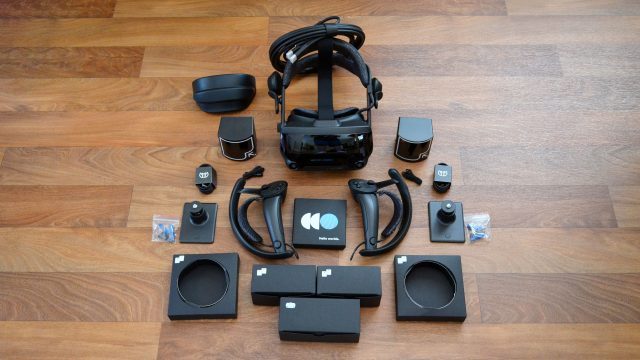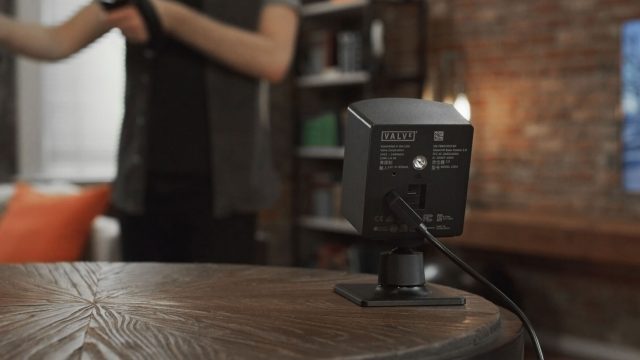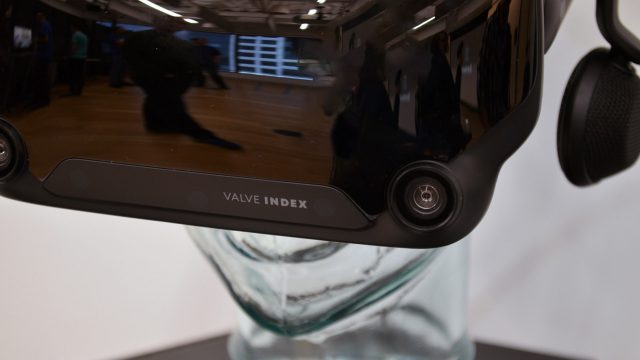Experience
Setup & Passthrough

While headsets like the Rift S are moving toward a more user-friendly approach by adopting inside-out tracking, Index is still reliant on the same external tracking paradigm as before. That means you’ll need a dedicated playspace with room to permanently or semi-permanently mount your base stations. This makes for a longer and more complex initial setup process, but means robust and performant tracking in the end.
Index can technically use a single base station for tracking, but the recommended setup is one base station at each corner of your tracked space to enable full 360 degree tracking in a room-scale space. A pair of 1.0 base stations support up to a 15 × 15 foot playspace, while 2.0 base stations (included with the Index full kit) support 22 × 22 feet, or up to 33 × 33 feet if you use four 2.0 base stations together. Valve says the minimum required space for Index is 6.5 × 5 feet.

SteamVR (the component of Steam which is required for using Index) still feels like a power user’s utility rather than an inviting portal into virtual reality. I’m a hardcore gamer who has been using VR for years now, and I still find some of SteamVR’s settings confusingly arranged and interconnected. Much of the options are simply not explained in any meaningful way, and novice users could easily degrade their experience by accidentally hitting the wrong check box.
SteamVR is also still finicky, and not very helpful when things go wrong. Sometimes you’ll fire up SteamVR and find that your base stations or controllers aren’t being detected for some reason. As an experienced user, I know that restarting SteamVR is a good first step, or that I can try re-pairing the controllers, but for new users troubleshooting problems like this means regularly consulting Google to figure out what’s going on.
One place where Index and SteamVR have gotten a little better is in the audio department. With Vive headsets the audio output frequently failed to switch from my PC to my headset. With Index, there hasn’t been a single time where the audio didn’t switch correctly. This seems like a minor point, but damn if it isn’t annoying to put on the headset, pick up the controllers, launch a game, and then realize there’s no audio… then you need to take everything off, saddle up to your PC, figure out the audio issue, then put everything back on before diving in.

Despite having two decent cameras on the front of Index, Valve is presently doing almost nothing with them. You can double-press the system button to look through the cameras, but it takes far too long to initialize the camera view for it to be any use for quickly peering outside of the headset. Valve has teased some stylized pass-through modes previously, but it seems they’re still treating the cameras as a development toy instead of a proper feature of the headset.
By contrast, the pass-through view on the Rift S is used to make setting up the play boundaries easier (by looking through the passthrough view and tracing the play area) and also makes onboarding easier because you can look through the cameras to easily pick up your controllers after you put on the headset which is much nicer than feeling around for the controllers and putting them on blindly. Valve really should steal these ideas to make Index a bit less cumbersome.
Content
Index has access to the entire slate of SteamVR content and is also officially supported by Viveport. Unofficially, Index can play Oculus content via the Revive mod which, thanks to the Index controllers, finally feels truly playable with non-Rift headsets, which means players don’t need to choose between having the best headset and having the best content. This could evaporate suddenly however if Oculus ever decides to block Revive, which unfortunately makes it a bit of a gamble to buy Oculus content to play on Index.
As for controller support, Index controllers have a legacy mode that makes all SteamVR content technically functional with the controllers, but developers will need to update applications to make full use of all of the features of the Index controllers.
The SteamVR Input system allows players to make custom controller bindings for individual games, which offers a lot of flexibility for players to make the Index controllers control games how they want. Unfortunately it’s a pretty complicated system and most users probably won’t dig too deeply into it. Fortunately, Valve allows users to share binding layouts directly in Steam, so hopefully the best bindings will float to the top for everyone to use.
With the launch of Index, you might have also expected Valve to launch its first full VR game, which the company confirmed is due to in 2019. Unfortunately Valve still hasn’t even announced the name of the game, and it seems it won’t be launching for some time yet. The launch of Index doesn’t seem to have inspired any significant new content to hit the market on launch day either, so if you’re an existing VR user picking up Index as an upgrade, you’ll likely be playing the games you already know for some time yet.
– – — – –
Got more questions? We’ve got more answers! Drop us a line in the comments below.
Disclosure: Valve provided Road to VR with an Index headset.






